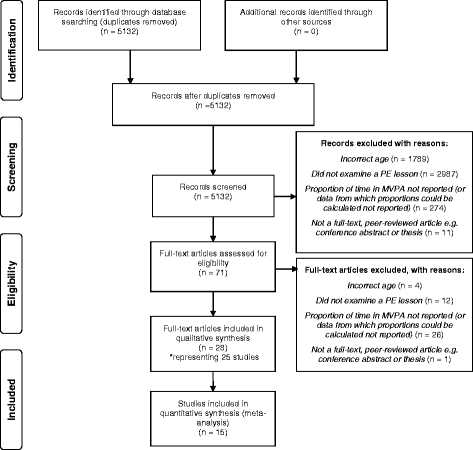A systematic review and meta-analysis of moderate-to-vigorous physical activity levels in secondary school physical education lessons
- PMID: 28438171
- PMCID: PMC5402678
- DOI: 10.1186/s12966-017-0504-0
A systematic review and meta-analysis of moderate-to-vigorous physical activity levels in secondary school physical education lessons
Abstract
Background: Schools play an important role in physical activity promotion for adolescents. The systematic review aimed to determine the proportion of secondary (middle and high) school physical education (PE) lesson time that students spend in moderate to vigorous physical activity (MVPA), and to assess if MVPA was moderated by school level (middle and high school), type of physical activity measurement and type of PE activities.
Methods: A systematic search of nine electronic databases was conducted (PROSPERO2014:CRD42014009649). Studies were eligible if they were published between 2005 and 2014; written in English; assessed MVPA in PE lessons of secondary (middle and high) school students; and used a quantitative MVPA measure (i.e., accelerometry, heart rate monitoring, pedometers or observational measures). Two reviewers examined the retrieved articles, assessed risk of bias, and performed data extraction. Random effects meta-analysis was used to calculate a pooled estimate of the percent of PE lesson time spent in MVPA and to assess moderator effects where data allowed.
Results: The search yielded 5,132 potentially relevant articles; 28 articles representing 25 studies (7 middle and 18 high school) from seven countries were included. Twelve studies measured MVPA through observational measures, seven used accelerometers, five used heart rate monitors and four used pedometers (including three studies using a mix of measures). Meta-analysis of 15 studies found that overall, students spent a mean (95% CI) of 40.5% (34.8-46.2%) of PE in MVPA. Middle school students spent 48.6% (41.3-55.9%) of the lesson in MVPA (n = 5 studies) and high school students 35.9% (28.3-43.6%) (n = 10 studies). Studies measuring MVPA using accelerometers (n = 5) showed that students spent 34.7% (25.1-44.4%) of the lesson in MVPA, while 44.4% (38.3-50.5%) was found for lessons assessed via observation (n = 9), 43.1% (24.3-61.9%) of the lesson for a heart rate based study, and 35.9% (31.0-40.8%) for a pedometer-measured study.
Conclusions: The proportion of PE spent in MVPA (40.5%) is below the US Centre for Disease Control and Prevention and the UK Associations for Physical Education recommendation of 50%. Findings differed according to the method of MVPA assessment. Additional strategies and intervention research are needed to build more active lesson time in PE.
Keywords: Adolescent; Class; Exercise; High school; Lesson; MVPA; Middle school; PE; Student.
Figures




References
-
- Gutin B, Yin Z, Humphries MC, Barbeau P. Relations of moderate and vigorous physical activity to fitness and fatness in adolescents. Am J Clin Nutr. 2005;81:746–50. - PubMed
-
- World Health Organisation. Global Strategy on Diet, Physical Activty and Health. In Physical Activity and Young People. 2014. http://www.who.int/dietphysicalactivity/factsheet_young_people/en/index..... Accessed 19th Nov 2015.
Publication types
MeSH terms
LinkOut - more resources
Full Text Sources
Other Literature Sources
Medical

